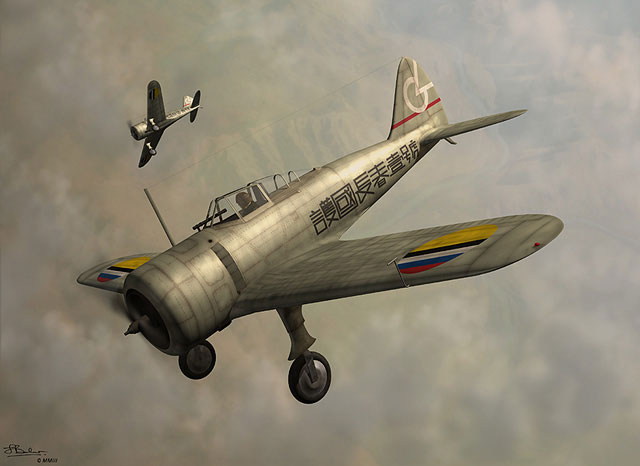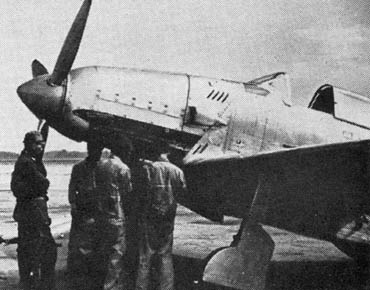An amazing history from Anabuki Satoru-

Anabuki’s greatest deed happened on October 8 1943, when at 12:10 hs four Hayabusas (one of them flown by Sgt Anabuki) taxied in Mingaladon airstrip to take off and intercepte several B-24s which were raiding against a Japanese convoy in Rangoon harbour. However, a fouled spark plug caused that Anabuki should delay his take off during 5 minutes. When he finally could scramble, was unable to find his three buddies and a second flight of four Ki-43s (which were also tasked to intercepte the bombers) because of the haze. Suddenly, when he got out of the hazy area, saw his target: 11 B-24s together with two escorting P-38s, which apparently did not notice him. Anabuki realized that -due to the hazy weather- none of his comrades had found the enemy and that he was completely alone. But Anabuki also noticed that he was in a perfect attack position against both the enemy fighters and bombers, and the surprise factor was at his side. Being a hunter by nature, Anabuki decided to take that chance despite the odds were against him.
So, Anabuki choose one of the unaware Lightnings, put it in the gunsight of his Ki-43 Hayabusa and badly shot it up (Anabuki saw the incendaries exploding around the P-38’s cockpit), breaking his attack and diving only when he almost collide the American plane. As he turned to repeat his attack, saw the P-38 trying a loop while leaving a trail of black smoke. Suddenly the P-38 stalled and went downwards, crashing near Yangon river. Then Anabuki jumped the P-38 leader, but his adversary was an experienced pilot because it immediatelly rolled and steeply dove. Knowing that his Ki-43 Hayabusa was excellent in dogfighting and could out-turn the P-38, but could not compete with the Lightning in dive and climb rates, Anabuki did not even try to follow the American plane, instead he concentrated in the bombers.
Sgt Anabuki closed to 1200 mts to the right of the bombers and 500 meters above them (he was flying at 5500 mts and the Liberators at 5000) and then rolled and dove. Anabuki knew that to shot down one heavily defended and huge four-engine bomber like the B-24 with the relatively weak weaponry of his Ki-43 (12,7 mm machineguns, with no cannons) was a very hard task, but he had the experience and the determination to do so, as himself accounted:
"All I could see was the enemy. I’m diving straight down towards the dark jungle. Life or death didn’t matter then. If the gods still need me they wouldn’t let me die. I see an image of my mother’s face. I think I heard her yelling Go, Satoru,go!. I think of what a strong woman my mother is. I think to myself I must be as strong. Distance closes further. 300, 200, I see my bullets get sucked into the gigantic B-24. Getting closer. 150, 100. I start firing my final burst.
The enemy’s defensive fire is fierce. Their formation is trailing a lot of gun smoke, raining bullets in successive bursts, but I know as long as I’m at this angle, they can’t hit me. My target starts smoking from the wing root. Even as I’m firing, the white smoke is getting bigger and bigger. I’m near collision and I break off to the left and to the rear of the enemy, diving vertically. Fifty some enemy machine guns are firing at me, but not a single bullet hit me as I speeded away out of their range. "
When Anabuki prepared himself for a second pass against the badly hit B-24, saw that it slipped at one side, the crew bailed out and the bomber began to spin. So, in few minutes he added one P-38 and one B-24 to his killboard.
But when he was ready to attack the bombers for the second time, suddenly saw tracers passing very close to his port wing. Anabuki sharply broke to starboard, avoiding the burst, but a second one struck his plane, being the Japanese pilot badly wounded in his left hand. Anabuki realised that the P-38 leader which had previously escaped was back, and it was willing to take him out. Despite the intense pain, Anabuki performed a series of the sharp turns, exploiting the superior turn capability of the Ki-43 Hayabusa and forcing the American pilot to gave up. When the P-38 pilot did so, Anabuki rolled his plane and reversed towards the Lightning. At point-blank range (about 30 mts) the Japanese ace fired and black smoke emerged from the P-38, together with oil which splattered over the windshield of the Ki-43 and temporarily blinded Anabuki. When he recover the sight, the P-38 was diving away again, this time definitively.
Despite he was wounded and his plane damaged (Anabuki noticed that at full throttle the engine airlocked), Anabuki made an provisional bandage with his muffler to stop the bleeding of his left hand, and performed his second pass against the B-24s. setting on fire one of them. When Anabuki climbed to began another pass saw that the crew of this Liberators could bail out (actually only 2 crewmembers). Then Anabuki began his third pass:
"At this point, the overwhelming thought in my mind was that today’s combat was over. I was about to turn back to base, and threw a final glance at the B-24s, which I presumed were by now too far away to follow. But alas! The bombers had apparently slowed down to cover their damaged comrade during my attack and was still within my attack range!
Looking back, it was a foolish thing to do, but I started to position myself for another attack despite my injury and the plane’s damages. The pain and the gas kept me hardly conscious, and my sight had deteriorated badly. My arm was hurting badly as the tightly wound muffler blocked blood circulation. But there was a thought that dominated my fading consciousness; if the enemy is within range, it was a fighter pilot’s duty to attack. To do otherwise would disgrace my family blood. My mother’s face flashes back. To go into combat now may mean my demise. Mother forgive me! But then I thought I heard her say ‘Charge, Satoru, and the way will open.’. I had no regrets. The enemy was there. I will just charge.
I was slowly gaining altitude to attack position for the third time. I was hardly conscious. All I could think about was ‘Charge, charge!’ Call me a foolish rustic warrior, I couldn’t have cared less. I was fighting to keep my consciousness and charging at the enemy at full throttle. The pain of my left hand was getting unbearable. I untied the muffler from my arm. As the blood started flowing, the pain went way, but the hand started bleeding like a dam burst open. "
So, Anabuki choose a third B-24 as his mark, and began his run against it. But as he was attacking it, suddenly ran out of ammo. In a normal situation, he would disengaged and headed home, but Anabuki took a very different decision: he would ramm the bomber:
"If I was my normal self, I would have banked my wings at the enemy and wished them luck and break away, but my mind was just obsessed with getting the enemy. My consciousness was nearly fading from the gasoline and the injury, my hand kept on bleeding, and I was out of ammunition. All these negative factors were piling up on me, but all I had in my mind was the existence of the powerful enemy in front of me. I was completely taken over by one of the fighter pilots’ instincts; the fighting spirit.
At that moment I was, by chance, right above the enemy. Although I was out of ammo, reflexes got the better of me and I instinctively put my plane in a dive. However, to start your dive from directly above the enemy means that by the time you are actually shooting, your attack will be at a shallow angle, presenting an ideal target for the enemy’s rear gunner. Just as the enemy started firing away, I maneuvered my plane to present the smallest possible target for the enemy, and charged on. Just as I expected, I found myself facing a wall of fire, and my plane shook as their bullets hit her. To makes matters worse, my engine output went down, and my angle was now so shallow that I was in their propeller wake and being thrown around wildly.
I was totally obsessed with getting the enemy. I decided to ram the bomber. ‘Take this! Yankee!’ I pulled up, but perhaps my action was too acute, and the next moment, my plane careened into the middle of the fuselage of the third plane of the left formation.
Although I had intended to ram her, I instinctively yanked my stick to evade the crash. The next moment a tremendous shock hit me with a thunderous roar and I just sat there dumbfounded watching my propeller eating away at the enemy’s starboard rudder at full 1130HP. There was nothing I could do now. It was as if the plane was being controlled by some gigantic force from outside. And all the while, I just sat there with the throttle pinned open.
The next thing I knew, the port wing of the “Kimikaze” hit the enemy’s elevator. With a great shock, the enemy’s elevator broke upwards, and my plane was thrown around about 45 degrees to the left, bouncing on the stabilizer and crash -landed on the enemy’s fuselage.
I would guess that the enemy was surprised, but so was I. In spite of my surprise, my plane proceeded to eat away at the fuselage of the B-24 and stopped at around the US insignia. I think it was just for a moment, but it felt like a long time, sitting on top of the enemy like that. While I was on top of the enemy, they didn’t shoot at me. I saw them staring at this rude intruder from their turrets and windows. They were probably not firing because I was too close, but I also had a strange worry in myself. I was seriously worrying about being carried to their base like this!"
Fortunatelly for him, “Kimikaze” slid off bomber’s back, and despite initially fell, later it began a controlled glide, and Anabuki was able to restart the engine, crash-landing in a beach shore near Rangoon, where he was rescued and cured, rejoining to active duty only 5 days later.
http://www.elknet.pl/acestory/anabuki/anabuki.htm







































 - And don’t forget the lack of armor and self-sealing fuel tanks.
- And don’t forget the lack of armor and self-sealing fuel tanks.











